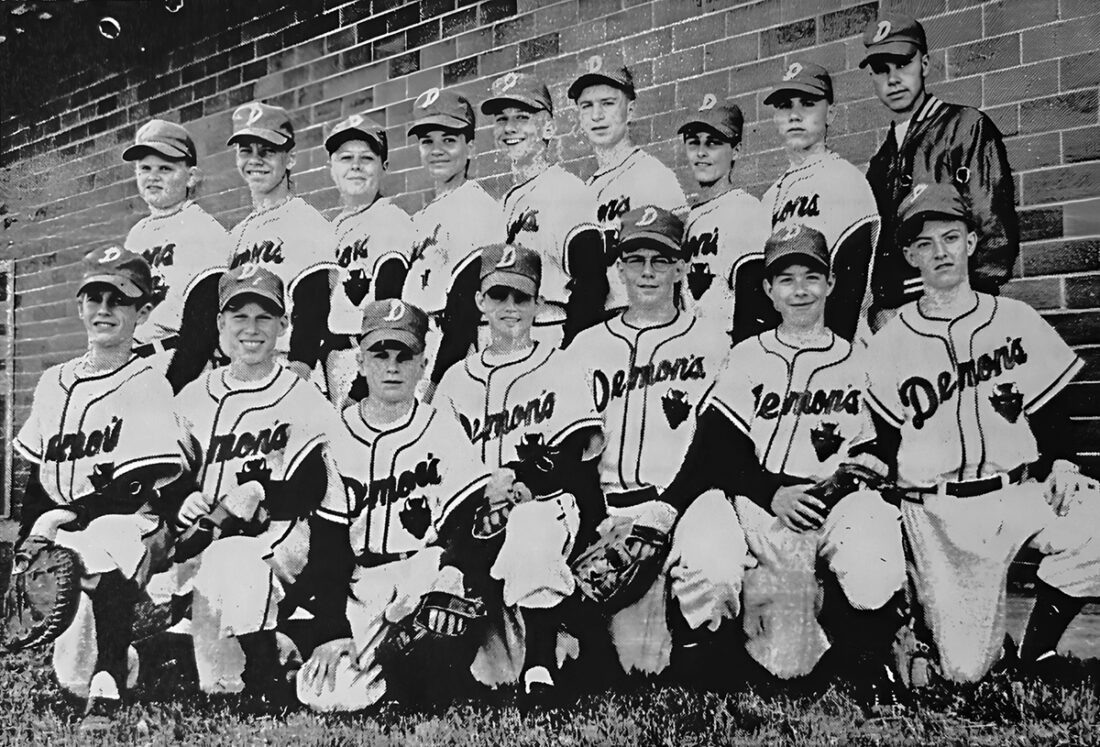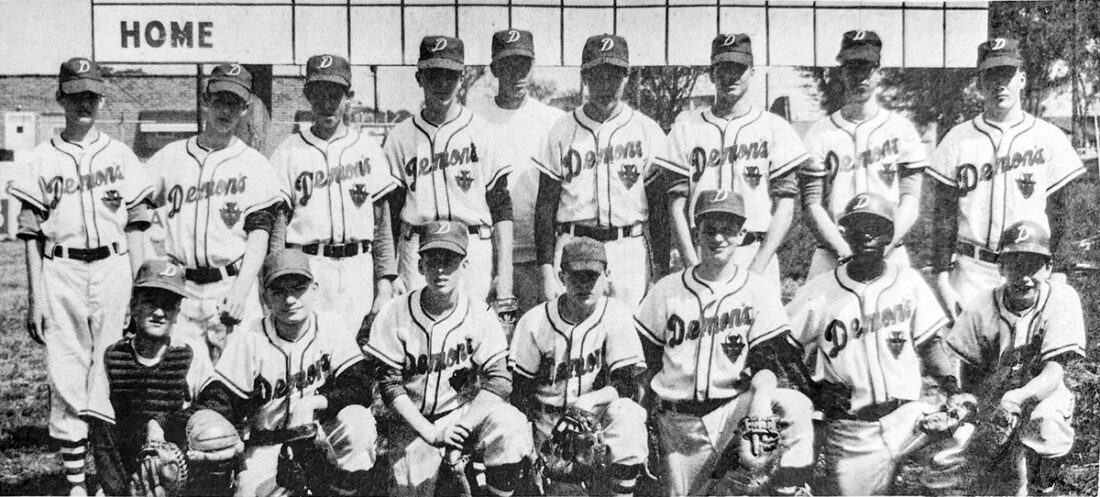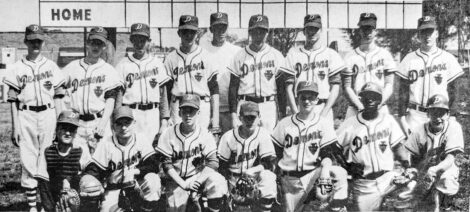Fort Dodge’s Boys of Summer remember their Demons days
-
-Submitted photo
1958 Fort Dodge Demons – Front row, from left: Dave O’Malley, Roger Schmidt, Lanny Teal, Denny Pelican, John Nordstrom, Jim Konvalinka, Mike McAnally. Back row, from left: Bruce Pliner, Phil Bretthauer, Marty Patterson, Maurice Heggen, John Shierholz, Ron Ruby, Bart Gabriel, Vince Kolacia and Coach/Manager Jerry Patterson.
-
-Submitted photo
1960 Fort Dodge Demons – Front row, from left: Al Nelson, Tracy Warbis, Roger Schmidt, Tom Goodman, Tom Bice, Billy Goodman, Bill McGough. Second row, from left: Denny Pelican, Dave O’Malley, Larry Hurley, Art Johnson, Marty Patterson, Maurice Heggen, Jim Konvalinka, John Kolacia. In back: Coach/Manager Jerry Patterson.

-Submitted photo
1958 Fort Dodge Demons - Front row, from left: Dave O’Malley, Roger Schmidt, Lanny Teal, Denny Pelican, John Nordstrom, Jim Konvalinka, Mike McAnally. Back row, from left: Bruce Pliner, Phil Bretthauer, Marty Patterson, Maurice Heggen, John Shierholz, Ron Ruby, Bart Gabriel, Vince Kolacia and Coach/Manager Jerry Patterson.
Fort Dodge’s Boys of Summer, now in the autumn of their years, still remember vividly those days of the 1950s and 1960s when they proudly wore the uniform of the Demons baseball team.
A lot of life – good and bad – has happened to the hundreds of boys who were coached by the beloved Jerry Patterson, whose name lives on in the memories of former Butler Demons and Fort Dodge Demons now in their late 70s and early 80s, maybe lucky enough to be watching their grandchildren and great-grandchildren play the sport they loved. And remembering those glory days, the ones that’ll pass you by “in the wink of a young girl’s eye”… as Bruce Springsteen sings.
“It was a pleasure playing with the Demons and for Jerry Patterson,” said Billy Goodman, the only Demon to graduate into professional baseball (seven years in the Reds and Twins organizations) after a sterling career with the Demons and at Fort Dodge Senior High under legendary Dodger coach Ed McNeil.
“I thank God often for providing the opportunity to meet Jerry Patterson and be a member of the Demons teams,” he added.”I know that baseball games in heaven involve Jerry Patterson, Ed McNeil and other people associated with Demons who are no longer with us.”
Marty Patterson, first cousin of Jerry, ranks as another of the most successful Demons. He was a fine pitcher and hitter who played for Jerry with the Butler and Fort Dodge Demons and the Fort Dodge Merchants semi-pro team, and then for the Dodgers, Fort Dodge Community College and the University of South Dakota. Marty served as interim head baseball coach at St. Edmond High School for the 1967 summer season and two years later was an assistant under McNeil when the Dodgers won their only state baseball championship.

-Submitted photo
1960 Fort Dodge Demons – Front row, from left: Al Nelson, Tracy Warbis, Roger Schmidt, Tom Goodman, Tom Bice, Billy Goodman, Bill McGough. Second row, from left: Denny Pelican, Dave O’Malley, Larry Hurley, Art Johnson, Marty Patterson, Maurice Heggen, Jim Konvalinka, John Kolacia. In back: Coach/Manager Jerry Patterson.
Today, Marty and his wife Laurann – who he first met when she played six-girl basketball in the ’60s for Cedar Valley of Somers – live in a Minneapolis suburb and try to keep track of former Demons. They’re the team’s historians, if you will.
What was it about the Demons experience that keeps it so alive in players’ memories today, 60-70 years later? What prompted someone like Phil Bretthauer, whose 70 years of life were packed with numerous career and sports accomplishments before he died in 2014, to include in his obituary that he “was an original member of the Fort Dodge Demons baseball team.”
Is it just plain nostalgia, for a time when life was simpler, when horizons were endless, when you could hop on your bike with bat, ball and glove in hand and ride to a nearby field to play baseball?
Maybe so, said Tom Bice, a retired Fort Dodge judge and attorney who played three years for the Demons.
“Playing for the Demons was a dream come true,” he said. “Great teammates – Billy Goodman, Tom Goodman, Fred Moeller, Billy McGough, Roger Schmidt, Ray Zehr, Zip Hanson, Ron Nordstrom, Kenny Cloud, Mark Wyatt and many other great guys — during an age of innocence.”
Is it that this was the first big accomplishment in life, going through tryouts at ages 10, 11 or 12 to determine if you had the right stuff to be a Demon and learning you passed?
Maybe so, said Dr. John Shierholz, a retired Ames radiologist who later played baseball for Grinnell College.
“My favorite memory about being a Fort Dodge Demon is related to becoming a Fort Dodge Demon,” he said. “Jerry Patterson had tryouts for positions on the team. I was a centerfielder and I distinctly remember having trouble sleeping that night because, ‘I was a Demon.'”
Maybe so, said Greg Sells, a Demons pitcher who attended St. Edmond High School and, who with his brother Tim, also once a Demon, operated a Sacramento, California., company that provided counseling to people with a variety of disabilities and consultation with attorneys regarding litigation.
“I was young when I played for the Demons,” he said. “And baseball was my favorite sport. To try out for, and then be selected, to play for what I thought was the premier team with excellent athletes was a big deal to me. It gave me more confidence. And it was encouraging for me to continue on in my various activities, both in sports and in life. Plus, it was a fun time.”
Is it that a foundation was set for a professional career based on the discipline and accountability that Patterson demanded of his players?
Maybe so, said Fred Moeller, retired from Moeller Furnace Co., now called Moeller Furnace and Air and in its fourth generation of family ownership, run by his son, Nate Moeller.
“Baseball helped me in life — the discipline Jerry instilled in all of us, the lessons, stick-to-it-iveness, getting along with all people,” he said. “Jerry made us young men when we were finished playing for him. He made us winners and had us learn about winning.”
Maybe so, added his lifelong friend Bice, who served as a district court judge from 2000 to 2019 and then a senior district court judge until April 2025.
“We learned the value of hard work and commitment,” he said. “Teamwork over individual accomplishment was a key to success. Respect for your teammates and adversaries was of great importance. We learned the rules and played within those rules. Our level of success raised the bar of expectation going forward in life.”
Maybe so, said Marty Patterson.
“From my first pickup game I learned that baseball can’t be played individually,” he said. “You need support and cooperation of others to be successful. So it is in life. People can’t exist without support. Baseball, like life, can throw a lot of curve balls. I’ve had a few screwballs come my way, too. To continue, you try other options and make adjustments. Talents are discovered and it takes hard work and strategy but also caring, love and respect. Lifelong lessons still apply today. I face ups and downs, some wins, some losses. It’s one day, even minutes at a time. I find joy in each day, count it a home run and give thanks.”
The beginnings of the Demons trace back to when a bunch of 10-, 11- and 12-year-old boys played pickup baseball at Butler Field in the summer of 1956. These boys became the core of the original Butler Demons baseball team.
“We were poor boys, from the south side, from Butler School,” Patterson said. “I pitched barefooted my first year because my parents couldn’t afford spikes for me. We were seven kids and the folks had all they could do to get regular shoes on our feet. It didn’t bother me much because I had a pretty good toe grip on the mound. But I did get spikes the following year.
“We were just boys who gathered to play baseball at Butler School’s playgrounds in the morning, went home for lunch, and came back to play in the afternoon. Jerry became interested in coaching us and formed the Butler Demons.”
Members of the original 1957 Butler Demons that played in 12-and-under Little League were Jim Bond, Phil Bretthauer, Bart Gabriel, Mickey Guarill, Maury Heggen, Vince Kolacia, Jim Konvalinka, Mike McAnally, Jerry McCaffrey, Richard Munson, John Nordstrom, Dave O’Malley, Marty Patterson, Bruce Pliner, Denny Pelican, Ron Ruby, John Shierholz, Roger Schmidt, Lanny Teal and Tracy Warbis. Coaches were Jerry Patterson, Richard Stirling and Leo Flynn.
After the team registered a perfect 35-0 season in 1957, parents of some of the boys wanted to keep the team together and organized the Fort Dodge Demons Baseball Association as a way to form a non-profit method of financing the team.
A top priority was finding a place to play, and the parents organized a fund drive to build a new park. Land on the east side of town, just to the north of U.S. Highway 20, was leased to the Demons by Western Transportation Co. Fundraising took such forms as publishing a 16-page brochure with advertising and sponsorships, selling advertising displayed on the outfield walls, and major league-quality uniforms with a sponsoring merchant’s name on the back of each. The team even had its own bus – a school bus brightly painted red and white and blue. And its driver — who else, but Jerry Patterson.
The new park was ready to go for the 1958 season with the Demons becoming a part of the state American Legion Midget baseball program for boys 15 and under. Joining the 1958 team were Al Nelson, Art Johnson, Reagan Bell and Denny Lawler.
“They funded and built Demons Field with dugouts, concessions and fences at the location currently occupied by Arby’s,” Moeller said. “It was a lighted field, so we could play double-headers at night. We practiced every morning and played nearly every night. We played all comers, Midget and American Legion teams. It was always a packed crowd. The uniforms were wool and styled like the major leagues.”
In their seven years, from 1957 to 1964, the Demons enjoyed much success. A high point: the record for the longest winning streak ever by a Fort Dodge baseball team. The Butler 12 years-and-younger team, in 1956 as 11 year olds, won its last 19 games in a row. In 1957 they went 35-0. In 1958 the same group became the Fort Dodge Demons and won their first 13 games of the season before losing. A record 67 consecutive victories over a three-year period.
“Jerry ran the team like a professional team,” Sells said. “Very clear start times, no messing around, and paying attention. I remember thinking we had the best uniforms in the world. Most teams generally had T-shirts or plain gray baseball shirts. The Demons had multicolored uniforms.
“When we would travel to play a game, there would be a pregame warm-up of the infield and outfield. Most teams would just walk out on the field, hit some ground balls and fly balls and that would be it. When the Demons got there, we would run out in single line, one behind the other, circling the bases then going out in the outfield, then coming back and breaking into individual groups for very organized pregame activities.”
Former Demon Bruce Pliner, who went on to play college football, said the team played all over Iowa.
“We also traveled out of the state a few times,” he said.”I remember traveling to Missouri and playing at a baseball camp. We also traveled to Okoboji where we played through the summer. We spent a lot of time at Arnolds Park.”
Del Blankenhagen was one of a number of players with brothers on the team. His brother Chuck started out with the Demons in 1962 and Del joined him in 1964.
I remember being the smallest player on the team and probably younger than most of them,” Blankenhagen said. “They didn’t have a uniform to fit me properly, so I had to play in an extremely baggy uniform. Not good for my self-esteem, but I overcame it.”
Indeed he did: at FDSH, he became the first Fort Dodger to be selected to the first team of the first All-State baseball team in 1968.
The era of the Demons was indeed, as Bice put it, an era of innocence, It was an era soon to be followed by the assassinations of President Kennedy, Robert Kennedy and Dr. Martin Luther King…the growth of the civil rights movement…the military draft taking more and more young men as the Vietnam War escalated and college campuses exploded in protests over the war…the Watergate scandal and the resignation of a president.
One of the first Demons to die was Billy McGough, victim of a motorcycle accident at the age of 16 in the summer of 1962, just a year after he played his last game for the Demons. He died just after his sophomore year at FDSH where he played a few varsity basketball games as freshman and started as a sophomore, becoming the first 10th-grader in the Big Six conference to make first-team all-conference.
Other Demons who have passed include Phil Bretthauer, Bart Gabriel, Mickey Guarill, Zip Hanson, Mike McAnally, Jerry McCaffrey, Richard Munson, Alan Nelson, Dave O’Malley and Roger Schmidt. Jerry Patterson died in 2012 at the age of 74 after a battle with cancer, leaving behind his wife Sandra and son Mark.
His service as a Marine in Vietnam eventually claimed Gabriel, who served three combat tours in the early 1960s. In his years after the war, he endured nine bouts with cancer caused by exposure to Agent Orange and died in 2017 at the age of 72.
In their own coaching careers, Billy Goodman and Tom Goodman said they learned much from playing for Patterson and McNeil.
“Ed was really old fashioned in being a disciplinarian more than Jerry,” said Tom Goodman, twice a first-team All-State basketball guard for the Dodgers who returned years later to coach them to the 1988 state title:.
“When I coached baseball, I also tried to be like Ed in some ways, but not to the strictness that Ed was, but my players knew who the boss was,” he said. “Ed was the boss, and I learned that from the first day as a freshman until the last day as a senior.”
Billy Goodman, a quiet, shy kid when he was spotted by Patterson playing YMCA baseball, said playing for the Demons “not only give me a taste of winning championships, but of long bus rides, which prepared me for the minor leagues of professional baseball…Each time I participate in Minnesota Twins Camps teaching kids from ages 7 to 14, I attempt to transfer the love for baseball given to me by Jerry to each and every kid in the camps. I often thank God for passing Jerry’s gift along to my son Kris, who now serves as the Major League process and development coach for the Tampa Bay Rays of the American League.”
All good things must come to an end and so it was with the Butler/Fort Dodge Demons. The team disbanded after the summer of 1964. Arby’s restaurant stands in roughly the area where Demons Field was located. Even the Butler ball fields, where it all began in the 1950s, are gone – they were built over in 2002 by a new Butler Elementary building that replaced the old school.
Ed McNeil, who died in 1991, and Patterson are gone as well, but their names are etched in the memories of their players and displayed for all time at Ed McNeil Field in Dodger Stadium and at Patterson Field.
Of his field, Jerry Patterson once said, “As for my life after life, the Holy Grail of my hopes, dreams and prayers is that if I do make it to Heaven, that our good Lord will give me the resources to build an exact replica of Patterson Field somewhere in his magnificent kingdom. If that does happen, ‘I’ll see you again at the ballpark.'”


